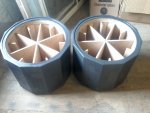There are several options – yes you can use BMS’s passive crossover on the HF driver and run the system 2 way + Sub. You can then process it on the Lake - its tricky- and flatten the phase response with all pass filters if you want.
The PM60 will work without FIR filters on any quality DSP crossover. The Mid and HF sections MUST be EQ-ed, they are not designed to have a flat response but work as a total system integrated with DSP.
There are quite a few stereo 4 way crossovers which you can use, you just can’t optimise the phase and amplitude response as much as those that have FIR filtering.
One processor that I would like to try is Linea Research ASC-48, I think it would be perfect for this project https://linea-research.co.uk/asc48/
The PM60 will work without FIR filters on any quality DSP crossover. The Mid and HF sections MUST be EQ-ed, they are not designed to have a flat response but work as a total system integrated with DSP.
There are quite a few stereo 4 way crossovers which you can use, you just can’t optimise the phase and amplitude response as much as those that have FIR filtering.
One processor that I would like to try is Linea Research ASC-48, I think it would be perfect for this project https://linea-research.co.uk/asc48/

